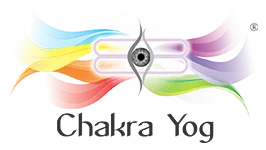Yoga Asanas for Vishuddha Chakra
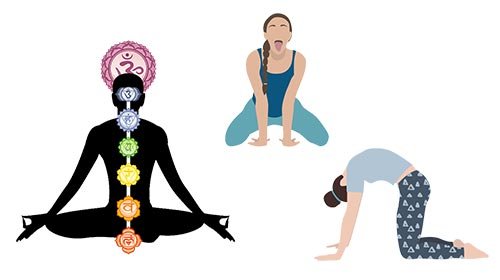
The life force energy (known as “prana”) passes through the subtle body through a number of channels known as “nadis” in yoga. These nadis meet at areas of amplified energy known as “chakras.” Chakras are swirling vortexes of energy in the subtle body that correlate to specific glands along the spine and within the head. They are named after the Sanskrit word for “wheel.” When the nadis get blocked due to bad behaviors and old patterns, the chakras become stagnant. The life force becomes sluggish as a result, which may lead to reduced physical, mental, and emotional health. Yoga practice cleanses and revitalizes the nadis and chakras, allowing prana to flow freely again.
Yoga is an incredibly useful method for releasing prana, or life energy, when it becomes wedged. Through yoga poses (asanas) and breathing, yoga dissolves musty energy and allows new energy into our chakra system. As a means of rebalancing our chakras so that they work optimally we may practice yoga as it definitely helps to either activate a blocked chakra or discharge excess energy from a dysfunctional chakra, for example when a chakra becomes overactive.
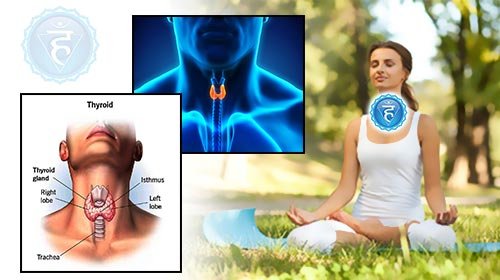
An effective way to bring to balance the Throat (Vishuddha) Chakra is to resort to yoga asanas practice on a regular basis, which stabilizes and balances your physical body’s energies at this energy vortex which acts as the compass of the system. It is from this point that we gain knowledge to take the right decisions in life and negativity dissolves as snow under the sun to illuminate our paths. It is in this chakra that the spiritual dimension of life start to open as a new space. The physical manifestation of a healthy Vishuddha Chakra is a good thyroid system. Yoga exercises involving the part of the body of this chakra are aimed to dissolve any blockage at this energetic level.
Yoga can be practiced at home, in natural environments or in a yoga studio. At the same time, each chakra is connected with different universal elements being Air, Earth, Water, Ether or Fire. While yoga asanas may be practiced with beneficial results in many distinct surroundings, it is recommended whenever is possible to do these in particular places related to the chakra’s element to enhance the whole experience and results. In the case of Vishuddha we need plenty of free space for expressing and experiencing ourselves in nature. Big settings whether they are placed near the rivers, seas or mountains where we can escape from the noisy distractions of everyday crowds of people and life are ideal. We need to find out our own uniqueness and speak and shout it out into the open in total freedom. If open spaces aren’t available near us then it would be beneficial to attend a calm yoga studio and talk with other yogis while practicing asanas. Blue décor helps.

Creating a home yoga studio has several advantages and may take your yoga practice to a whole new and enhanced level. It helps you to immerse yourself in yoga so that it becomes a more important part of your everyday rather than something that is exclusively performed at a studio. Indeed, yoga experts and teachers acclaim contrary to popular belief to practice yoga at your own pace in your own place rather than in busy and distracting public yoga centers which tend to rush the practice in too active modes and with limited time and procedures. They reiterate that the practice of yoga should be paced at each person’s rhythm thus allowing a much better integration of the practice as it involves aspects like focus, absorption, breathing or meditation. Therefore, getting involved in public spaces with yoga experienced teachers is principally suggested mostly to get started with the right postures under their supervision at first, but more personal places and environments are more suitable for yoga practice for the healing and balancing of our energy centers (chakras) in the long-term.
Even in the tiniest of areas, you can carve out a nook and corner for your home yoga studio. The first item you’ll need is a yoga mat, or if you can’t find one, a towel will do. It will protect you from slipping and sliding while you practice yoga.
Below are some other items you may need in your daily yoga practice:
- Yoga Bolsters are used to aid in relaxing, softening postures, and opening up the body. As an alternative, you may make an improvised bolster out of a pillow covered in a blanket. It forms an oval and may be used as a bolster to rest against.
- Yoga Blocks are used to aid in the practice of yoga by bringing the floor closer to you if you are unable to reach it in certain poses. If you don’t have access to yoga blocks, you may use thick books.
- Yoga Straps are used to assist yoga practitioners in achieving a greater range of motion and increased flexibility. Likewise, resistance bands may also be used as an alternative.
- Yoga blankets are great to have on hand since they can help you sit comfortably and relax in restorative positions. As an alternative to yoga-specific blankets, you may use blankets from your bed, throw blankets from your sofa, or towels.
- Yoga cushions and chairs aids in meditation and they are utilized to keep the body in a comfortable sitting posture. They tilt the pelvis, allowing you to sit erect and securely in meditation position. If they are not accessible, you may sit on any cushion from your home, such as one from your sofa or bed, while meditation.
- Altars and the things that decorate them are utilized to integrate the energy of your yoga practice into your surroundings. Deities’ sculptures and sacred symbols and pictures are often placed.
Begin your practice by sitting. Close your eyes and focus your concentration on your Throat. Take some time to be calm and silent, and observe your deepest self. Drop beneath the buzz of your mind into the cave of your Throat and listen for
the inner voice. It takes work to become silent and open enough to connect intimately with your inner self. You will gradually be able to recognize the difference between the inner voice of your Throat and the restless chatter of your mind if you practice listening in on a regular basis. You will be able to see both over time. This inner listening develops discrimination. Discrimination encourages wise decisions that take you to your Throat’s calling, your mission. As a consequence, you will no longer feel confused or disoriented in life.
Vishuddha (Throat) uncovers who you truly are – “your true beingness”, clear about what you truly need, ready to transcend all negativities (mental impurities and negative qualities) so that you can dig up the powers and potentials of your soul to shine your light that removes the darkness of ignorance. To do this, this chakra empowers clarity and articulation of thoughts, ideas and words, creative expression, style of communication, hearing, listening and the choices you make.
Vishuddha chakra connects the heart to the mind. When this space is clear, the wisdom of both is united and profound spiritual truths flow freely.
HALASANA (Plough Pose)
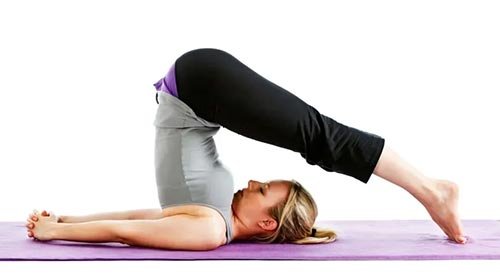
Lie down on the floor with both arms on each side of the body, palms down, and knees together. Breathe gently and deeply, and relax your body. Lift your legs off the floor gently, using your powerful core muscles, until they are perpendicular to the floor. Maintain straight and joined legs. Raise your buttocks with the support while pressing your arms on the floor. Roll your spine till your big toes can touch the floor above your head. Do not force your feet to contact the floor. What important is that the legs remain straight. Maintain a straight spine in the final posture, with the spine perpendicular to the floor. If this is your first time, you may use your arms to keep your back from sliding over by putting both hands behind your ribs. To enhance support, bring your arms closer together, interlocking the fingers of both hands. If you can’t do this, simply pull your arms closer together and interlock your thumbs. Your chin should be nestled in the center of your collar bones in the final position. Yes, this is a challenging posture, and you will need a lot of work to attain it. However, never push yourself into it; otherwise, the tension on the neck muscles may result in damage. Stretch your legs and arms in the other way and maintain the posture for 15 seconds to a minute, depending on your degree of comfort. Breathe slowly and deeply. To exit the posture, gently descend the spine, bringing the legs vertical and lowering them to the ground. Finally, release and relax your body.
SARVANGASANA (Shoulderstand)
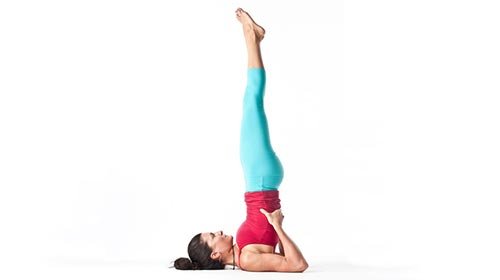
Place your blankets on the floor. Your back should rest on the floor, and your shoulders should be precisely at the edge of the covers. Begin in Plough Pose with your hips and legs above on an inhale (Halasana). Take a minute to tuck your upper arms under you, so you’re high onto your upper arms and shoulders. Please keep in mind that if your feet do not reach the floor, consider putting them on your block or see below for a wall adjustment. Draw your upper arms beneath you, as high as possible onto your shoulders. Remember, this is a Shoulderstand, not a Neckstand. Bend your elbows and lay your hands flat on your back. As clothes might be slippery, it helps to place your hands directly on the skin of your back. Lift your right leg gently up to the sky on an inhale, followed by your left. Reach through your knees and press the backs of your arms into the covers. Begin with 10 breaths and gradually increase to longer holds.
ADHO MUKHA SVANASANA (Upward Facing Dog)
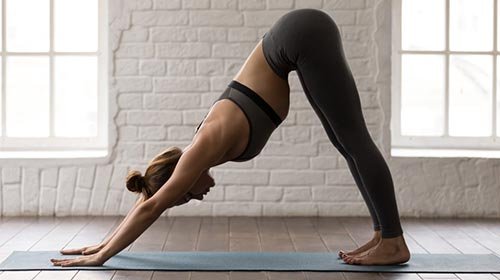
Press your hands into the mat and roll the tops of your shoulders back on an inhalation. Lift your chest and bring the bottom tips of your shoulder blades forward, toward your front torso. Imagine energy lines extending diagonally through your body from the lower points of your shoulder blades to your collarbones, as if the shoulder blades were supporting the collarbones and opening your upper chest. Lift your body and legs off the floor by straightening your arms and pressing the tops of your feet down. Your wrists, elbows, and shoulders should now be “stacked” vertically in a single smooth, dynamic line.
MARJARYASANA (Cat Pose)
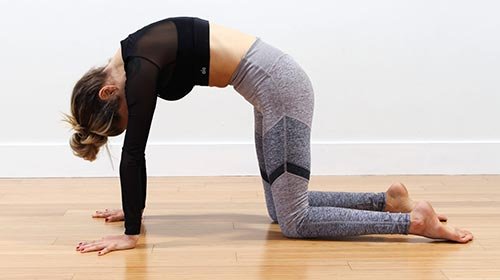
Tabletop begins with your hips straight above your knees. Hands should be shoulder-width apart and slightly ahead of the shoulders. The wrist creases should be parallel to the mat’s front. Firmly press down with your hands. Exhale while rounding your spine toward the ceiling. Drop your crown of the head and tailbone. Pull your lower belly button in and up. Spread your shoulder blades by pushing your hands away from the floor. Maintain mobility in your spine by keeping your hips above your knees and your arms straight. Return to a neutral spine to exit the stance.
MATSYASANA (Fish Pose)
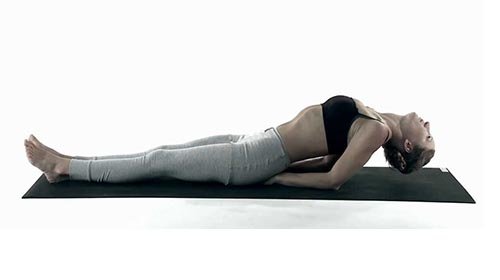
Sit in Padmasana, Ardha Padmasana, or Sukhasana, keeping your spine straight and your shoulders and head strong yet comfortable. When focusing on the asana, keep your body attentive. When resting flat on your back, gently lean rearward, supporting your body with your arms and elbows. Bend the elbows and draw the hands from the sides of the head beneath the chin. Clasp your opposing elbows and lay your hands on the mat beneath your chin. Individual comfort dictates whether the eyes are kept open or closed. Hold this posture for 1-2 minutes, breathing rhythmically (final position). To relieve the stance, slowly unclasp the hands and bring them down to the sides. Gently return to the starting place, using your hands for support.
Restorative Yoga poses for Vishuddha:
Restorative yoga poses are practiced always at the end of the yoga practice to provide rest to the body and self-assimilation of the yoga asanas previously done. They are all about slowing down and incorporating what has been done.
NECK RELEASE
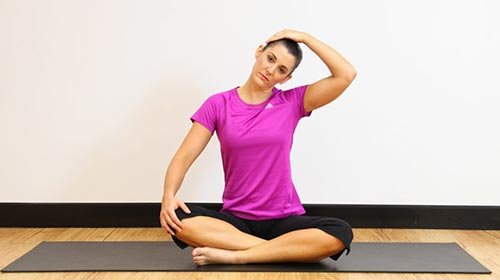
Extend your spine long and root down into your base from a comfortable sitting posture. Extend your right arm to the right. Begin to slowly release your head and let it hang to the right. To develop a sturdy base, drag your right shoulder and shoulder blade down. Extend your left arm approximately 6 inches above the floor and reach out and down to produce traction and a significant stretch on the left side of your neck. Take 5–10 deep breaths here. Please be patient. It takes time for blood to flow through and mend tight and stiff muscle tissue, so try to hold for as long as you can without feeling discomfort. Make sure your breathing is calm and deep, and that your eyes and jaw are relaxed. Return to the middle, stop for a minute to note the change, and then swap sides.
CORPSE POSE (Savasana)
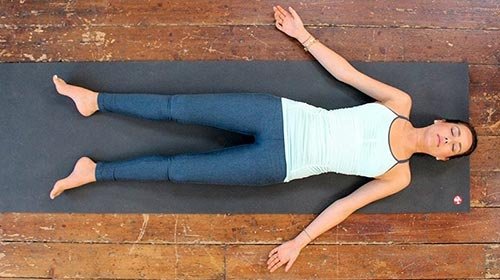
When you’re finished, fall back in Savasana and allow your body to relax as if you’re floating on top of water, drifting into a tranquil and pleasant repose.
Aside from the yoga positions outlined above, cultivating a deeper feeling of steadiness throughout your practice may take various forms. If visualizations have previously benefited you in your practice, consider imagining or wearing the color blue, which is the color of the Throat (Vishuddha) Chakra. This vision may assist you in rekindle your inner flame revealing a stronger connection while practicing the above yoga asanas. Singing mantras and also using sound vibrations in the background is another excellent approach to connect with your Throat (Vishuddha) Chakra while doing yoga.


